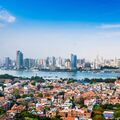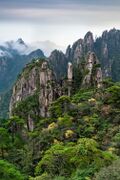Seonko
Imperial State of Seonko | |
|---|---|
|
Flag | |
Motto: 밝은 달은 우리 가슴 일편단심일세 ("The bright moon is like our heart, undivided and true.") | |
| Capital and city | Haewon |
| Official language and national language | Seonese |
| Ethnic groups (2018) |
|
| Religion |
|
| Demonym(s) | Seonese |
| Government | Unitary parliamentary Constitutional Monarchy |
• Emperor | Baekjun |
• Prime Minister of Seonko | Kwon Yebin |
| Legislature | Central Assembly |
| Establishment | |
• Establishment of modern state | 23rd October 1946 |
| Population | |
• 2020 estimate | 42,108,746 (26) |
| GDP (PPP) | estimate |
• Per capita | $42,646 |
| GDP (nominal) | 2019 estimate |
• Per capita | $26,679 (tbd) |
| HDI (2020) | 0.910 very high · tbd |
| Currency | Seonese On (SKO) |
| Date format | yyyy/mm/dd (CE) |
| Driving side | right |
| Calling code | +tbd |
| Internet TLD | .sk |
Seonko (Seonese: 성국 善國, romanised as Seongguk), officially known as the 'Imperial State of Seonko is a large country in Eastern Ochran. With a population of just over forty one million, Seonko is bordered to the north by (-) (-) to the south and by (-) to the west as well as sharing sea borders with Tsurushima. The greater metropolitan area of the capital, Haewon is home to over eleven million of the population of Seonko. The majority of Seonko’s people live in the east where the the country touches the sea. Geographically Seonko is diverse, while most of its territory covered by hilly forest, the northeast is largely flat plains dominated by agriculture and industry. Contrastingly the northwest and much of Seonko’s western border is made up of mountains and valleys, much of this landscape has been untouched for centuries leaving an abundance of flora and fauna.
Seonko’s history has been dominated by a series of dynasties. Beginning with Kang in 1306, Gyeon, Seon, Bak, Cho and Do followed after, with the Do dynasty remaining in power to this day. Prior to the Kang unification of 1306, the territories now forming Seonko were a collection of warlord administered states. The Kang warlords of the northeastern state eventually conquered the neighbouring kingdoms under the newly formed Kang Dynasty, ruling from Haewon, the present day capital of Seonko. The Kang emperors ushered in a sophisticated and refined culture as well as a strictly adhered to social class division. While Kang united and brought peace to Seonko, the Seon dynasty is today most highly revered and had a lasting impact on Seonese culture, even giving name to the modern nation. The ousting of militaristic emperor in the beginning of the 20th Century marked the transition to a constitutional monarchy, and implementing Seonko’s first democratically elected body, which would transform by 1953 into a functioning parliament while the monarchy retained a purely symbolic role in governing. Although ultimate power theoretically remains with the royal family, subsequent emperors almost never utilised this to its full extent.
21st Century Seonko is a liberal democracy and economically developed nation of over forty million people with thousands of years of a unique culture and society. Following the transition to a democracy, by the 1960s Seonko had experienced industrialisation and witnessed a large increase to its standard of living as well as greater technological advancements. The nation consistently ranks highly in areas of healthcare and education alongside a respect for civil freedoms. It has become international renowned for its growing popular culture, fashion, cuisine and as a top tourist destination.
Etymology
History
Prehistory
Early Seonko
Warlord States
Dynasty Era
Modern Seonko
Geography
Environment
Forested hills are the dominant geographical feature of Seonko comprising the majority of the nation’s interior and coastal regions, before gradually increasing in height to form two mountain ranges running along the western border. The southern range is known as the Namgangmaek, while the northern range is the Bukgangmaek. Their native Seonese names refer to the fact both ranges are the sources of the nation’s two longest rivers. The hills of the north are rolling but become rugged as one travels south. Karst limestone rock forms have formed in multiple locations between Yeosang and Naemyeon. The valleys and hills of the rest of the nation shield Seonko’s north east, which is comprised of largely flat expansive grassland, a majority of which has become cultivated for agricultural purposes. Rice paddies constitute the largest percentage of this farmland. Outside the capital, a stretch of flooded coastal plains and mudflats have immense ecological and cultural value for this region of the country. Today, over 65% of the country is covered by dense forests, a combination of deciduous and evergreen trees. Furthermore, much of this has become protected natural reservations and parks. Strong conservation efforts have allowed for thriving populations of large wild animals namely tigers and bears. Cheonggok is the largest island in Seonko and lies off the eastern coast of the Po’an prefecture and is inhabited by approximately four thousand people. Many other small uninhabited islands can be found scattered along this stretch of rocky coastline. The most heavily urbanised region is the densely populated eastern coast from the capital Haewon in the far north all the way south to the second largest city. Large swathes of the furthest south Naemyeon prefecture are undeveloped and sparsely inhabited, with subtropical rainforests covering the hillsides all the way to the tip of the Jinnam Peninsula.
Seonko’s climate is mostly humid and subtropical in nature. However, the northern mountaineous regions are characterised by drier more temperature seasons. Average summer temperatures in the north range from 22°c to 28°c whereas average winter temperatures in this region are 8°c to 12°c. However further south the climate becomes warmer with winters averaging 14°c with summer temperatures regularly soaring beyond 28°c. Summers receive the heaviest annual rainfall owing to the arrival of monsoons maintaining high levels of humidity while winters in contrast are usually dry and cool. The south being an exceptions where winter may equally be damp.
Climate
| Climate data for Seonko | |||||||||||||
|---|---|---|---|---|---|---|---|---|---|---|---|---|---|
| Month | Jan | Feb | Mar | Apr | May | Jun | Jul | Aug | Sep | Oct | Nov | Dec | Year |
| Average high °C (°F) | 7 (45) |
11 (52) |
16 (60) |
21 (70) |
25 (77) |
29 (84) |
33 (91) |
34 (93) |
28 (82) |
25 (77) |
20 (68) |
18 (65) |
22 (72) |
| Average low °C (°F) | 4 (40) |
7 (45) |
13 (55) |
15 (59) |
21 (69) |
24 (75) |
26 (79) |
28 (82) |
23 (73) |
18 (65) |
14 (58) |
9 (48) |
17 (62) |
| Average precipitation mm (inches) | 71 (2.8) |
54 (2.14) |
96 (3.76) |
61 (2.42) |
96 (3.79) |
184 (7.23) |
159 (6.25) |
218 (8.60) |
104 (4.11) |
54 (2.12) |
52 (2.03) |
36 (1.40) |
1,185 (46.65) |
Government
Seonko’s first democratically elected body was formed in 1955 as functioning parliament with a new consideration after a period of reform following the end of a dictatorship. The Seonese monarchy retained a purely symbolic role in governing, and although ultimate power theoretically remained with the royal family, subsequent emperors almost never utilised this. Modern Seonko is a liberal democracy with elections held nationally every five years with voters determining the Prime Minister as well as the make up of the Central Assembley. Currently five parties have seats, with the plurality held by the ruling Social Democratic Party of Seonko and led by Prime Minister Choi Jaehyun. Each prefecture has it’s own governor, who is elected every four years during regional elections.
Administrative Divisions
Seonko is composed of fourteen prefectures, including the island of Cheonggok. Yongjae, Samsan, Pyeongwol, Sangje, Mungye, Dokchul, Po’an, Yeosang, Hanbyeon, Naemyeon, Suyeong, Gyoseok and Ulhae make up the remaining prefectures. The Haewon Capital Territory has been granted special status as it is home to the nation’s capital and therefore seat of government.
Largest cities or towns in Seonko
Seonese Cities Authority | |||||||||
|---|---|---|---|---|---|---|---|---|---|
| Rank | Prefecture | Pop. | |||||||
 Haewon  Yeonju |
1 | Haewon | Haewon Capital Territory | 11,671,802 | Daewha Daewha  Sangcheon | ||||
| 2 | Yeonju | Suyeong | 5,429,246 | ||||||
| 3 | Daewha | Yeosang | 2,187,535 | ||||||
| 4 | Sangcheon | Ulhae | 1,811,290 | ||||||
| 5 | Kamsan | Pyeongwol | 1,344,976 | ||||||
| 6 | Hyeonsu | Suyeong | 816,798 | ||||||
| 7 | Wonhae | Dokchul | 713,221 | ||||||
| 8 | Gwangsu | Po’an | 709,852 | ||||||
| 9 | Dongcheon | Po’an | 650,760 | ||||||
| 10 | Yangnam | Dokchul | 632,095 | ||||||
Demographics
Ethnicity & Languages
Seonko is one of the world’s most ethnically homogeneous nations with over 97% of the population being Seonese. Exceptions to this are in border regions and large cities where since the 1980s immigration has increased from other regions of Ochran and different parts of Ajax usually in search of education or economic opportunities. Currently immigration to the country continues to rise but the majority of which (62%) are originally from Ochranian countries. A growing presence of expat communities from other continents is also noted. With a population of 42 million, the country is heavily urbanised with a quarter of the population living in the Haewon Capital Territory alone. Urbanisation has increased rapidly since the 1970s when many left traditional agricultural lives in the interior to settle in towns and cities along the eastern coast. While the total population has almost doubled since the 1930s, it has also began ageing and a declining birth rate has been recorded since 2002. Families have a three person average, and typically only one child. Owing to a high standard of living, the average life expectancy is 81 years.
Seonese is the sole official language with standard Seonese being the primary language of business and education even in regions where local dialects are more commonly spoken on a day to day basis. There are four main dialects all of which are mutually intelligible with differences only in accent, and certain vocabulary. The four are Northern, Southern, Interior and Western. Standard Seonese is based on what was formerly referred to as the Haewon accent, which itself is a variant of Northern. Many in the country are bilingual being able to converse at least at basic level in other Ochranian or Belisarian languages.
Religion
While Seonko may be a largely homogeneous country, the same does not hold true to religion. Approximately half of the Seonese population are non religious or non practicing while the other half is a mix of Buddhists, Christians or traditional folk religions, in many cases a blend of all of the above. Interestingly there is no great urban/rural divide in terms of religion with all faiths commonly found across the country both in major cities and quiet villages. However some prefectures do have majorities. The central prefectures for example are more heavily Catholic, while the south leans more to Buddhism. Additionally many other smaller religious communities exist in cities with higher immigrant populations, as a result there are now mosques, and Hindu temples to be found in Haewon, Yeonju and Daehwa. Seonko has since the end of the 17th century had a reputation of being open to many religions and proselytism within the nation, leading to the diverse religious make up of the modern country.
Economy
International Relations
Military
Seonko’s military comprises nearly 200,000 personnel both active and reserve. Prior to 2010 enlisting was mandatory for all male citizens for a period of 18 months. The ruling Social Democratic Party of Seonko has since first coming to government in 2012 made reducing military funding and the number of active military personnel a key aspect of their governance. While this move was met with some opposition from other parties in the early years, it has more recently allowed for their growth in popularity amongst the general public. Today the most active branch of Seonko’s military is the navy, followed by the air force, ground troops remain lower in number and their role is largely restricted to managing border controls and port activity.



